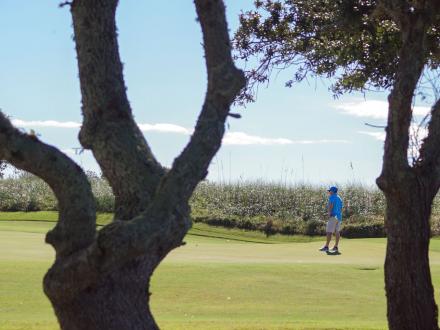
Golf is more than just a game – it is a tradition steeped in history, precision, and camaraderie. However, the terminology can feel like a foreign language for those new to the sport. Words like "birdie," "par," and "handicap" are mentioned effortlessly by seasoned players, leaving beginners scratching their heads as to what they are talking about.
Understanding the plethora of unique terms is not just about sounding like you know your way around a golf course; it is about fully engaging with the game, improving your skills, and connecting with fellow players. Whether preparing for your first round or looking to sharpen your knowledge, getting acquainted with golf's unique lingo is a crucial step in mastering this timeless sport.

1. Par, Birdie, Eagle, & Bogey
The fundamental aim of every golfer is to achieve the lowest score possible, both on each hole they play and the total for all 18 holes. At the heart of golf lies the concept of "par," a term that describes the standard number of strokes a skilled golfer is expected to take to complete a hole. Most courses will typically have a combination of the following:
Par 3: A shorter hole, usually requiring just one stroke to reach the green.
Par 4: A medium-length hole, where you'll typically need two strokes to get to the green.
Par 5: A longer hole, requiring three shots to reach the green.
Each hole has a specified "par," and golfers aim to achieve the lowest number of strokes possible. If the hole is played in one stroke less than the specified par, that is classified as a "birdie" (two strokes under is referred to as an "eagle," which is typically rare, especially for amateurs). For example, finishing a Par 4 hole in just three strokes is a birdie and shows a sign of skill and an achievement worth celebrating. While the aim is always to achieve a par score or better, beginners frequently face the other side of a par, known as a "bogey."

2. Handicap
The term "handicap" in golf is a personalized measure of skill, allowing players of varying abilities to compete on a level playing field. It represents the number of strokes a player is expected to shoot over par during an average round of golf. The beauty of the handicap system is that it makes the game fair and inclusive, whether you are a seasoned pro or a newcomer to the sport. In simple terms, the lower the handicap, the better the golfer!
A handicap is derived from your recent golf scores and the difficulty ratings of the courses you played. It is a mathematical formula that calculates the potential of a player, not just their average performance. For example, a golfer with a handicap of 10 is expected to shoot 10 strokes over par on a standard course. For many golfers, lowering their handicap is a key measure of progress. As your skills improve, your handicap will decrease, indicating that you are becoming a more consistent and competitive player. Regular practice, lessons, and familiarity with different courses can all contribute to lowering your handicap over time

3. Tee Box, Fairway, Rough, Green, & Bunker
Understanding the composition of a golf course is also critical in ensuring every first-time golfer is prepared for the first tee. The designated area, which is the start of every hole, is referred to as the "tee box" and usually will have colored markers that identify where you should start. Most courses will have multiple markers corresponding to the scorecard, allowing for varying golfers' standards to determine how much of a challenge they want to face.
The "fairway" is the well-manicured area of the course that leads from the tee box to the green. Hitting the fairway is the goal because it provides a smooth surface for your next shot, making it easier to control your ball. Either side of the fairway is called the "rough" and is the longer, thicker grass area. Landing your ball in the rough makes your next shot more challenging because the thicker grass can interfere with your swing and ball control.
The "green" is where the hole is located, with grass cut very short for putting. Reading the slope and speed of the green is crucial for accurate putting. Finally, many courses will have "bunkers" strategically positioned to make the hole more challenging, either along the fairway or by the green.

4. Mulligan
While not recognized in official rules, mulligans are popular in casual or friendly games, offering a second chance to get the shot right. In many competitions, you may be allowed to buy mulligans before the round for your team, as it will help you all achieve a better score if used strategically.
Mulligans are strictly for recreational play and are not permitted in official tournaments or under the official rules of golf. When heading to the course to practice, especially when you are playing alone, giving yourself mulligans is a great way to improve your game.

5. Hook, Draw, Slice, & Fade
One of the most important golf skills is understanding and controlling the flight of the ball. Four common terms used to describe ball flight are hook, draw, slice, and fade. These terms reflect the direction in which the ball curves during its trajectory, and they are key to mastering different shots. Two of these, draw and fade, are typically what golfers aim for as they emphasize "control," while a hook or a slice, unfortunately, is the extreme of both.
A hook is a shot that curves sharply to the left (for right-handed golfers) or to the right (for left-handed golfers). It typically occurs when the clubface is closed relative to the swing path at impact. A slice is a shot that curves dramatically to the right (for right-handed golfers) or the left (for left-handed golfers). It is one of the most common mishits among beginners and is often frustrating because it results in lost distance and accuracy.
On the contrary, a draw indicates a controlled right-to-left shape for right-handed golfers, or a fade is a gentle left-to-right ball flight. Most professional golfers typically will have a preferred ball flight, and very rarely do golfers hit a perfectly straight shot.





